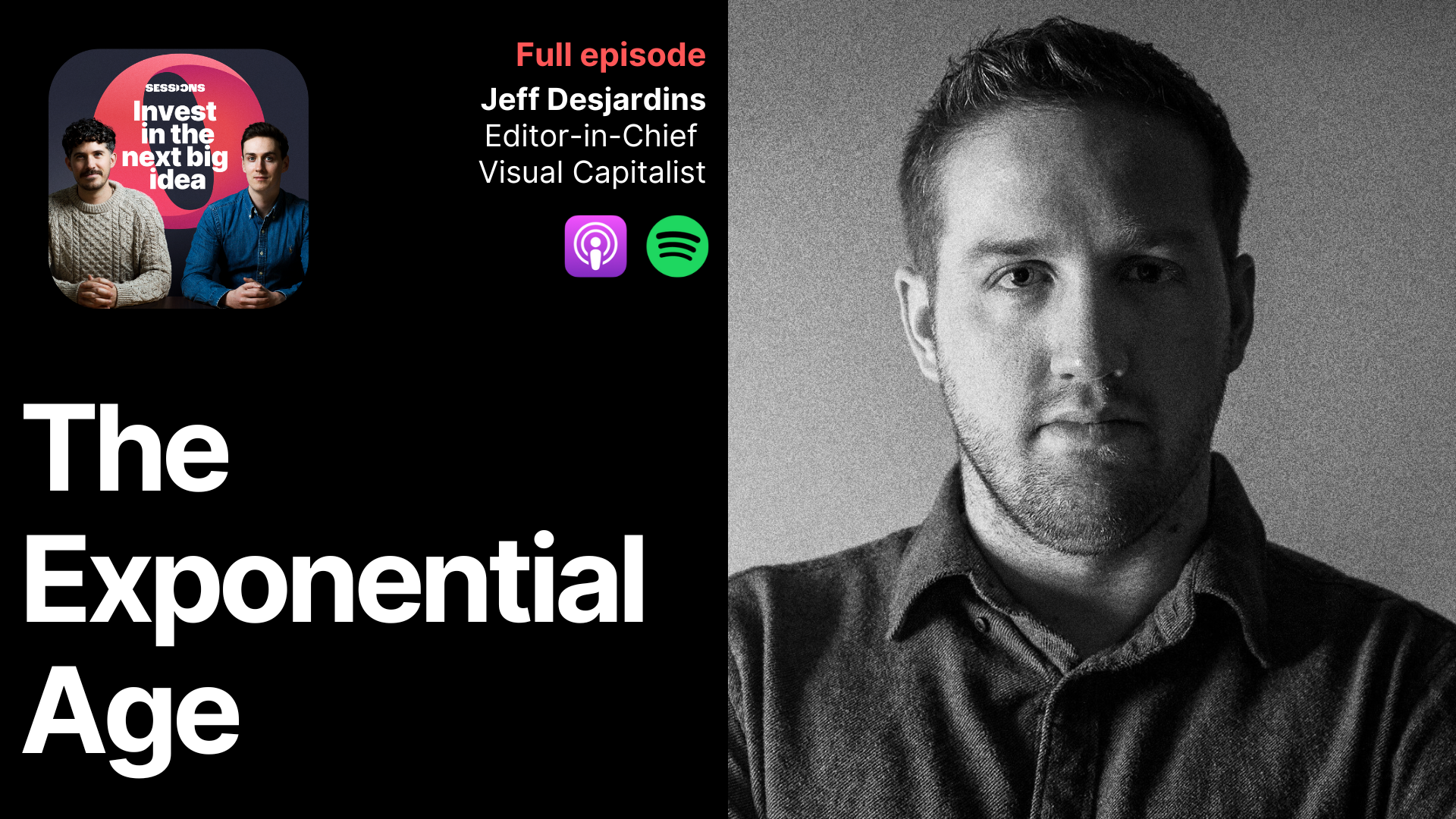Jeff Desjardins, Editor-in-Chief of Visual Capitalist, joins OPTO Sessions to discuss how to distinguish signals from noise in a world in which technology is developing at exponential rates and the amount of data available is greater than ever before. In addition, he highlights some of his top investment themes.
Jeff Desjardins is Editor-in-Chief of Visual Capitalist, a publication that, in his words, aims “to make data more accessible”. Desjardins is also author of the book Signals: The 27 Trends Defining the Future of the Global Economy.
Both Visual Capitalist and Signals are rooted in a mission to take the proliferation of data that exists in the world and make it comprehensible. In the case of Visual Capitalist, this means taking data and visualising it in a way that helps people to understand it quickly and intuitively.
In Desjardins’ view, it is more difficult than ever to distinguish true value-adding signals from the noise around them, largely due to the overwhelming proliferation of data. Similarly to the rate of technological progress that makes it available, the amount of data increases exponentially over time, says Desjardins.
Signals and Noise
“What are the trends that are almost impossible to argue against, from a business, social and economic context?”
Desjardins calls these trends signals.
He applies two key criteria when defining a signal. First, a theme should have longevity — having existed for a long time and being expected to endure into the future. Secondly, it should have a significant impact on business, society and culture.
Despite his own love of cryptocurrencies and decentralisation, Desjardins did not include crypto in his book because he struggled to find sufficient evidence of its longevity over time.
He contrasts it with ageing populations: “No-one can argue against that. We’re seeing it across the world from every metric. If you’re looking at median age and where it’s predicted to go by the United Nations, the world is just getting older. It’s just a simple fact.”
Ageing is the first theme laid out in Signals, due to its high ‘signal-to-noise ratio’. The term refers to the clarity and certainty of a signal; for Desjardins, it reflects the degree to which expert opinions form a consensus around the existence or impact of a given signal.
“The signal-to-noise ratio looks at how much clarity there is in a particular signal versus how many different expert projections and opinions are going different ways and interfering with that signal. It’s a way to highlight an aspect of certainty in these projections.”
The New Space Race
Signals also focuses on technological innovation, and in particular on space. Desjardins views the expanding space industry as being driven by cheap supply rather than strong demand.
“There are a lot of things you can go and do in space. The question is just how much it costs to do that thing,” he says. “It’s only recently that we’re starting to see these developments from the supply side, where the cost of bringing a kilogramme of material up into space is exponentially smaller, and that is enabling all kinds of demand drivers.”
One of the reasons for this cost reduction is reusable rocket technology. Desjardins says the traditional mode of rocket launching was as if “every time you had to use your car, you had to discard it after the trip”.
Re-using rockets for multiple missions, however, “brings down the cost base by a massive percentage.
“That’s what brings down the cost of taking a kilogram into space. I’ve seen estimates that the latest SpaceX ship makes it as much as 10x cheaper to bring stuff up into space than it was 10 or 20 years ago.”
Alongside signal-to-noise, ‘signal range’ is an important metric for Desjardins. The term indicates the degree of implications of a given signal. Desjardins gives the space theme a signal range of three out of five.
“It’s not going to impact every single industry, at least in the medium term.” However, “space is wider-ranging than one might think”. For example, Desjardins highlights that the synthesis of the active ingredients for pharmaceuticals is starting to take place in zero-gravity environments. “You can create far better protein crystals up in space than you can here,” he says.
The signal-to-noise ratio for space is a more robust four out of five. “It’s pretty clear that this is an area in which developments are going to continue to happen,” he says.
“It’s pretty clear that this is an area in which developments are going to continue to happen.”
The Exponential Age
Desjardins believes that technological milestones are currently being met far more rapidly than at any prior point in history.
“The Human Genome Project, the invention of social media, the iPhone, the Large Hadron Collider, CRISPR: all these things have happened in the last 10–20 years. If you think of that, in comparison to what was going on, for example, in the 1800s or the 1700s, it's at a completely different speed.”
Adoption is also speeding up exponentially. “When telephones were first invented, it took about 75 years for 80% of the US population to gain access to telephone technology.” More recent innovations have caught on quicker: the internet took 22 years to reach mass adoption, while the smartphone took 12–15 years.
With this rapid rate of adoption for new technologies comes a corresponding increase in technology’s share of financial markets. Desjardins highlights the surprising fact that, in the early 1990s, transportation was the biggest sector in the US stock market.
“Communications and technology, which are the biggest today, actually together only comprised about 5% of the overall stock market.”
LINKS TO THE INTERVIEW:
Disclaimer Past performance is not a reliable indicator of future results.
CMC Markets is an execution-only service provider. The material (whether or not it states any opinions) is for general information purposes only, and does not take into account your personal circumstances or objectives. Nothing in this material is (or should be considered to be) financial, investment or other advice on which reliance should be placed. No opinion given in the material constitutes a recommendation by CMC Markets or the author that any particular investment, security, transaction or investment strategy is suitable for any specific person.
The material has not been prepared in accordance with legal requirements designed to promote the independence of investment research. Although we are not specifically prevented from dealing before providing this material, we do not seek to take advantage of the material prior to its dissemination.
CMC Markets does not endorse or offer opinion on the trading strategies used by the author. Their trading strategies do not guarantee any return and CMC Markets shall not be held responsible for any loss that you may incur, either directly or indirectly, arising from any investment based on any information contained herein.
*Tax treatment depends on individual circumstances and can change or may differ in a jurisdiction other than the UK.
Continue reading for FREE
- Includes free newsletter updates, unsubscribe anytime. Privacy policy



